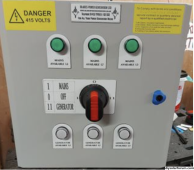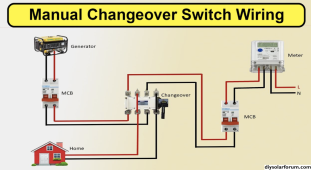New here - hi!
So most new inverters are able to do EPS, and to my understanding this "effectively" has the inverter pretending just to be a full off-grid generator. (usually a diesel motor strapped to a dynamo).
But when looking in the manual of my current frontrunner inverter (SolaX G4 Hybrid 12kW), there's a whole bunch of complexity - in particular identifying "EPS devices/rings" - items you want to be able to run when there's an outage, such as your fridge, network cabinet, some lights, maybe a microwave. It seems sensible however it requires a ton of extra wires, clever switching stuff.. and the major downside is that any device you didn't predict would be needed (hey can I charge my laptop from this socket, or watch a bit of TV..) can't be powered easily without running some cables.
Why can't I just have power-from-grid normally (and perhaps some fancy-ish setup to give stuff back to grid but I care somewhat less about this)
And if the grid goes away:
1/ Bighuge 3 phase switch. CLICK

2/ EPS out from my inverter now connected to the main house distribution board input. Maybe need an extra earth stake or something?
3/ <run around the house manually switching off my victorian electric kettle collection>
4/ Happiness?
This is the 1-phase version of this:

What am I missing? Assuming the changeover works, I see no way for my grid to anger (or electrocute) people from the outside grid, and once we're back to normal I change back? I can imagine a few edge cases where eg I 'change back' but the inverter is still in EPS mode and... I can't quite imagine this is a problem (it's not like we are connecting the EPS port to the grid or something..)
As for power needs, well, clearly if you switch on eeeeeverything in the entire house you can reach many amps (I calculated 50amp max for my house) but that is in the 'fast-charging my car whilst oven, microwave, hob, vacuum, kettle..' - not a situation you would do if you know you're on battery.. I don't think I'm too worried about accidentally tripping the fuse (?) on the inverter EPS out - I think the 12kW solax can handle 6000W on a single phase max, which should be fine for 90% of my cases.. maybe I should get the 14kW so even my 7000W hob would be fine running off a single phase..
Thoughts?
So most new inverters are able to do EPS, and to my understanding this "effectively" has the inverter pretending just to be a full off-grid generator. (usually a diesel motor strapped to a dynamo).
But when looking in the manual of my current frontrunner inverter (SolaX G4 Hybrid 12kW), there's a whole bunch of complexity - in particular identifying "EPS devices/rings" - items you want to be able to run when there's an outage, such as your fridge, network cabinet, some lights, maybe a microwave. It seems sensible however it requires a ton of extra wires, clever switching stuff.. and the major downside is that any device you didn't predict would be needed (hey can I charge my laptop from this socket, or watch a bit of TV..) can't be powered easily without running some cables.
Why can't I just have power-from-grid normally (and perhaps some fancy-ish setup to give stuff back to grid but I care somewhat less about this)
And if the grid goes away:
1/ Bighuge 3 phase switch. CLICK

2/ EPS out from my inverter now connected to the main house distribution board input. Maybe need an extra earth stake or something?
3/ <run around the house manually switching off my victorian electric kettle collection>
4/ Happiness?
This is the 1-phase version of this:

What am I missing? Assuming the changeover works, I see no way for my grid to anger (or electrocute) people from the outside grid, and once we're back to normal I change back? I can imagine a few edge cases where eg I 'change back' but the inverter is still in EPS mode and... I can't quite imagine this is a problem (it's not like we are connecting the EPS port to the grid or something..)
As for power needs, well, clearly if you switch on eeeeeverything in the entire house you can reach many amps (I calculated 50amp max for my house) but that is in the 'fast-charging my car whilst oven, microwave, hob, vacuum, kettle..' - not a situation you would do if you know you're on battery.. I don't think I'm too worried about accidentally tripping the fuse (?) on the inverter EPS out - I think the 12kW solax can handle 6000W on a single phase max, which should be fine for 90% of my cases.. maybe I should get the 14kW so even my 7000W hob would be fine running off a single phase..
Thoughts?


